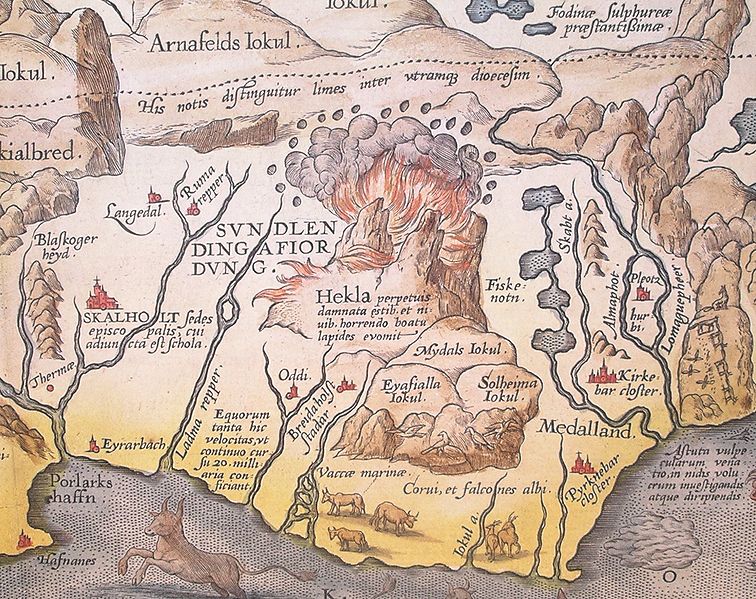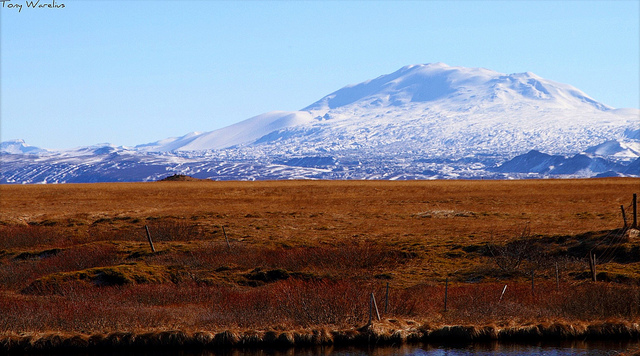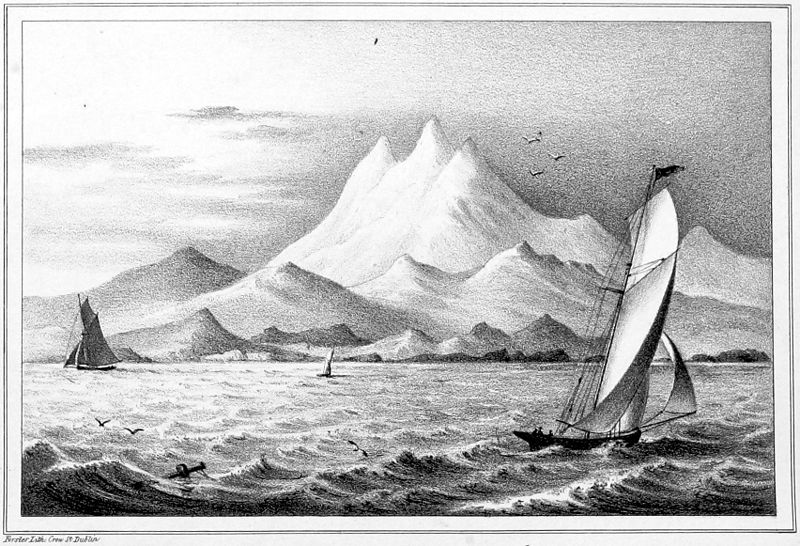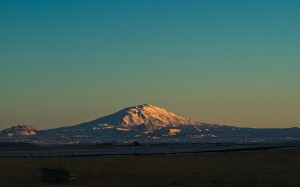Hekla volcano – temperature on the rise. Posted by hulda on Mar 25, 2014 in Icelandic history, Uncategorized
As spring approaches we begin to look at the volcanoes a bit more closely, especially the two that are overdue their eruption schedule: Katla and Hekla. In Iceland it’s actually very typical that eruptions begin in the spring or early summer because that’s when the snow and ice melt off the mountains and even subglacial volcanoes have less weight sitting on them. Hekla is not under a permanent ice layer although she’s usually snow-capped, in fact recently she’s been thawing for the warmer half of a year. That’s usually a sign that she’s about to go boom –
– if she feels like it, that is. Hekla is a bit overdue her usual activity routine at the moment, as you may have seen in the news. Media abroad absolutely loves the possibility of another Icelandic volcano causing trouble so big headlines are made whenever one of them shows signs of life, and since Hekla’s been brewing the most she’s a popular topic. Most times the hysteria around Hekla rises, peaks and falls within a few days while Icelanders look on somewhat uninterested, because what the media likes to paint as imminent destruction/end of the world looks very different to the people who have lived here all their lives and have personally witnessed Hekla erupt several times. So far she hasn’t ended the world even once.
 Photo by Tony Warelius.
Photo by Tony Warelius.
Several farms are located near Hekla that have housed people for generations. It goes to show that for most of its long life Hekla has been survivable, although during its earliest documented eruption in 1104 it spewed so much ash that farms all the way to the distance of 70km had to be abandoned. Some of these places have been dug up later on much in the same way as Pompeii.
Katla, however, is a cause for alertness although she’s much further away from the Capital City than Hekla. The problem is in the volcano type: Katla has a thick layer of ice over her shoulders all year around, which means that there’s always a good chance of a glacial flood when she decides to go. Hekla on the other hand mostly throws up ash and rocks, which means that the destruction she causes happens on a lot smaller area and likely won’t wash away the most important road of Iceland, the Ring Road 1 that nearly always suffers great damage from Katla’s jökulhlaups (= glacier floods).
This is not to say that Hekla would be harmless, far from it: her worst feature is that the eruptions, when they begin, give almost no warning beforehand, and that there’s always going to be a large amount of ash and lava – Hekla is single-handedly responsible of a large quantity of Iceland’s tephra layers. It’s just easier to stay safe around her when you know you won’t have to try to escape a flood wave that carries along poisonous gas. However, the situation currently is that there’s more magma in Hekla’s magma chamber than there’s been for years, the mountain has bulged up a lot and the officials have issued a warning to not approach her at all. Yet – and this point never seems to emerge in foreign news – she’s also showing no signs of imminent eruption or any reason to expect one even this year.
 A map by A. Ortelius showing Hekla and the south coast of Iceland (source).
A map by A. Ortelius showing Hekla and the south coast of Iceland (source).
These warnings to be alert near a certain volcano are often released in Iceland, in fact a similar one was made last year when Hekla suddenly began to inflate. Like mentioned, she habitually sits quiet right up to the moment of eruption – it’s the unpredictability that’s the biggest threat to hikers around the area, and I foresee there being quite a few of them on Hekla all the time… you see, this being Iceland means that official warnings are often a way of making sure someone goes there just because it’s said to be a bad idea. To battle that, and in hopes of diminishing the danger to humans, the officials have now also put up signs around the general area and released a “what to do if you’re caught in Hekla eruption on her slopes”-chart in both Icelandic and English. You can view it here.
 Photo by Tony Warelius.
Photo by Tony Warelius.
But what if you really, really, really want to go hike on Hekla regardless? Here’s some advice for you:
1) Don’t go. There are other hiking routes all around the country that are currently safe and just as beautiful, if not far more beautiful, as the ones on Hekla.
2) If you want to go there anyway, let someone know where you’re heading. This is automatic advice to anyone going hiking in Iceland, always let people know where you’re going, which route you’re planning to take if you’re going to hike from place A to place B, and an estimation on when you’ll be back. If something happens to you on the way people know to send help.
3) Bring a phone with you, and if possible get the 112Iceland app. It enables you to send your location to the emergency services fast and easy, no matter if you even know it yourself. Also, and not to put too fine a point on it, the emergency number of Iceland is 112 (definitely not 911)!
4) If you’re on the mountain and an eruption begins, call the emergency number immediately and try to make your way back the same route you got there if it’s at all possible. Keep in mind that Hekla can give you as little warning as 30 min before she erupts and that usually the longer she’s been dormant before an eruption the more catastrophic it will be. We can technically speaking expect something large-ish this time although probably nothing similar to her worst. It’s also good to keep in mind that unlike most volcanoes of her type, Hekla is capable of producing pyroclastic flows so all volcano viewers should keep a respectful distance should she erupt.
5) You don’t actually have to be anywhere near her to watch Hekla erupt, not even in the country. There are web cameras constantly recording her such as Míla (here) and Jón Frímann’s web cam (here). You can also follow the earthquakes etc. here at the Veðurstofa Íslands, and Jón’s posts on all volcanic activity on Iceland in his blog (here).
 Hekla in the 1800’s (source).
Hekla in the 1800’s (source).
Recent news about Hekla
Tveir jarðskjálftar við Heklu (= Two earthquakes at Hekla) here in Icelandic.
Hekla Volcano Eruption Hazard Signs Put Up here in English.
Kvikusöfnun meiri í Heklu en árið 2000 (= Magma accumulation in Hekla larger than in 2000) here in Icelandic.
Engin merki um að Hekla sé að bæra á sér (= No sign of Hekla eruption beginning) here in Icelandic.
Gasmælingar aukast við Heklu (= Gas measurements increasing at Hekla) here in Icelandic.
The first image of this blog post is by Axel Kristinsson.
Some volcanic vocabulary with explanations – English subtitles are available!
Today I’ll recommend a piece of music instead of a band – Hekla op 52 (here), by Jón Leifs. It holds the record of being the loudest piece of classical music in the world, and to perform it properly the orchestra needs f.ex. sirens, many sets of rocks with hammers, sheets of steel, anvils, metal chains and a cannon (yes, a real one)! It’s probably needless to say but Hekla is indeed massively loud and can be heard all around Iceland when she erupts.

Build vocabulary, practice pronunciation, and more with Transparent Language Online. Available anytime, anywhere, on any device.
About the Author: hulda
Hi, I'm Hulda, originally Finnish but now living in the suburbs of Reykjavík. I'm here to help you in any way I can if you're considering learning Icelandic. Nice to meet you!






Comments:
Fandral:
This is why I have respect for people in Iceland. They not only weathered the financial crisis that hit them, but even the many volcanos in their country. I saw a video once about the most destructive eruptions. Goodness, I would not like to be caught in one.
hulda:
@Fandral Thankfully the grand majority of volcanic eruptions here are very small scale, some can even go by almost unnoticed if they happen under a glacier. But indeed, the big ones can be catastrophic. 🙁